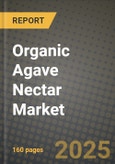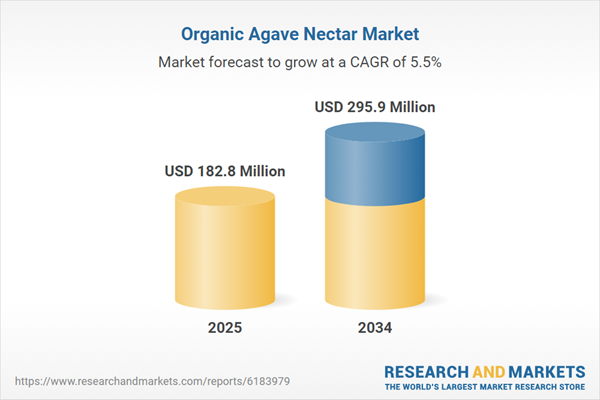Organic Agave Nectar Market
The Organic Agave Nectar market sits at the intersection of clean-label reformulation, plant-based lifestyles, and premium natural sweeteners. Produced primarily from blue agave via controlled enzymatic hydrolysis and gentle evaporation, organic grades emphasize certified provenance, pesticide-free cultivation, and transparent farm-to-bottle traceability. Top applications span beverages (RTD teas, functional tonics, cold-brew coffee), bakery and snack bars (as both sweetener and binder), breakfast cereals and granola, dairy-alt yogurts and desserts, sauces/condiments, and premium foodservice syrups for coffee chains. Latest trends include low-GI messaging, organic + Fair Trade co-certifications, darker/amber variants for flavor layering, powdered formats for dry mixes, and custom viscosity profiles for industrial users. Brands are shifting toward reduced-sugar SKUs and “no artificial sweetener” claims, blending agave with stevia/monk fruit or fibers to meet taste and calorie targets while preserving label simplicity. On the supply side, growers and processors invest in regenerative practices, biodiversity corridors, and water-efficient cultivation; processors advance low-temperature concentration and continuous filtration to preserve flavor while cutting energy intensity. Competitive dynamics pit organic agave against honey, maple, coconut sugar, date syrups, and novel low/zero-calorie options such as allulose - each with distinct taste, cost, and claim architectures. Barriers include agricultural cyclicality linked to agave use in spirits, certification and audit costs, evolving sweetener taxes and front-of-pack labels, and retailer pressure on private-label pricing. Nevertheless, consistent quality, versatile functionality, and a strong fit with vegan and clean-label platforms position organic agave nectar as a resilient ingredient for both retail brands and B2B formulators.Organic Agave Nectar Market Key Insights
- Demand drivers and positioning
- Applications moving fastest
- Formats and functionality
- Blends and sugar reduction
- Sourcing, certifications, and ESG
- Supply cyclicality and risk
- Regulatory and labeling context
- Competitive set and substitution
- Route-to-market and channel mix
- Innovation horizon and quality
Organic Agave Nectar Market Reginal Analysis
North America
Adoption is propelled by better-for-you beverages, specialty coffee chains, organic snacks, and private-label expansion across natural and conventional retail. Retailers prioritize traceable, multi-certified suppliers and dependable bulk availability for seasonal programs. Sugar-reduction roadmaps in beverages and refrigerated desserts favor agave-based blends over artificial sweeteners for taste and label acceptance. Foodservice pumps and portion packs widen café penetration and drive menu consistency.Europe
Organic seals, sustainability scorecards, and clean-label norms in the UK, DACH, Nordics, and Benelux underpin steady inclusion in bakery, muesli, and dairy-alt categories. Flavor-forward amber grades complement artisanal and organic bakery traditions, while light grades support botanicals in adult soft drinks. Retailers scrutinize provenance narratives, packaging recyclability, and transport emissions. Regulatory nuance around sugar claims shapes copy and limits overt glycemic messaging.Asia-Pacific
Urban health awareness and café culture in Australia/New Zealand and parts of East/Southeast Asia are opening premium sweetener sets. Agave finds traction in specialty cafés, craft beverages, better-for-you snacks, and modern trade e-commerce. Local competition from palm/coconut and fruit-based sweeteners is significant; agave’s neutrality and vegan credentials help in international brands and export-oriented co-packing. Education around grades, use levels, and authenticity is pivotal.Middle East & Africa
Growth clusters around premium hospitality, modern retail in the Gulf, and health-focused expatriate communities. Agave features in specialty cafés, smoothie bars, and imported organic shelves. Consistency, halal-aligned processing, and temperature-resilient packaging matter for hot-climate logistics. Price sensitivity drives selective usage; however, high-end hotels and gourmet retailers adopt for menu differentiation and international brand standards.South & Central America
Regional familiarity with agave plants supports consumer acceptance, while export-oriented processors emphasize certifications and traceability to serve global CPG and foodservice accounts. Domestic premium retail and specialty cafés incorporate organic agave in bakery and beverage innovation. Logistics, currency dynamics, and competition from local cane, coconut, and fruit syrups influence pricing and mix. Producer stories - farm communities, regenerative practices - reinforce brand value at shelf.Organic Agave Nectar Market Segmentation
By Type
- Light Agave Syrup
- Dark Agave Syrup
By Application
- Bakery
- Beverages
- Confectionery
- Others
Key Market players
Wholesome Sweeteners Inc., Madhava Natural Sweeteners, NOW Foods, Ciranda Inc., Global Goods Inc. (Agave In The Raw), Malt Products Corporation, Sisana Sweeteners, The Groovy Food Company, Domino Foods, Inc., The Tierra Group, The IIDEA Company, Maretai Organics Australia, Hain Daniels Group, Dipasa USA Inc., Suzanne’s Specialties Inc.Organic Agave Nectar Market Analytics
The report employs rigorous tools, including Porter’s Five Forces, value chain mapping, and scenario-based modelling, to assess supply-demand dynamics. Cross-sector influences from parent, derived, and substitute markets are evaluated to identify risks and opportunities. Trade and pricing analytics provide an up-to-date view of international flows, including leading exporters, importers, and regional price trends.Macroeconomic indicators, policy frameworks such as carbon pricing and energy security strategies, and evolving consumer behaviour are considered in forecasting scenarios. Recent deal flows, partnerships, and technology innovations are incorporated to assess their impact on future market performance.
Organic Agave Nectar Market Competitive Intelligence
The competitive landscape is mapped through proprietary frameworks, profiling leading companies with details on business models, product portfolios, financial performance, and strategic initiatives. Key developments such as mergers & acquisitions, technology collaborations, investment inflows, and regional expansions are analyzed for their competitive impact. The report also identifies emerging players and innovative startups contributing to market disruption.Regional insights highlight the most promising investment destinations, regulatory landscapes, and evolving partnerships across energy and industrial corridors.
Countries Covered
- North America - Organic Agave Nectar market data and outlook to 2034
- United States
- Canada
- Mexico
- Europe - Organic Agave Nectar market data and outlook to 2034
- Germany
- United Kingdom
- France
- Italy
- Spain
- BeNeLux
- Russia
- Sweden
- Asia-Pacific - Organic Agave Nectar market data and outlook to 2034
- China
- Japan
- India
- South Korea
- Australia
- Indonesia
- Malaysia
- Vietnam
- Middle East and Africa - Organic Agave Nectar market data and outlook to 2034
- Saudi Arabia
- South Africa
- Iran
- UAE
- Egypt
- South and Central America - Organic Agave Nectar market data and outlook to 2034
- Brazil
- Argentina
- Chile
- Peru
Research Methodology
This study combines primary inputs from industry experts across the Organic Agave Nectar value chain with secondary data from associations, government publications, trade databases, and company disclosures. Proprietary modeling techniques, including data triangulation, statistical correlation, and scenario planning, are applied to deliver reliable market sizing and forecasting.Key Questions Addressed
- What is the current and forecast market size of the Organic Agave Nectar industry at global, regional, and country levels?
- Which types, applications, and technologies present the highest growth potential?
- How are supply chains adapting to geopolitical and economic shocks?
- What role do policy frameworks, trade flows, and sustainability targets play in shaping demand?
- Who are the leading players, and how are their strategies evolving in the face of global uncertainty?
- Which regional “hotspots” and customer segments will outpace the market, and what go-to-market and partnership models best support entry and expansion?
- Where are the most investable opportunities - across technology roadmaps, sustainability-linked innovation, and M&A - and what is the best segment to invest over the next 3-5 years?
Your Key Takeaways from the Organic Agave Nectar Market Report
- Global Organic Agave Nectar market size and growth projections (CAGR), 2024-2034
- Impact of Russia-Ukraine, Israel-Palestine, and Hamas conflicts on Organic Agave Nectar trade, costs, and supply chains
- Organic Agave Nectar market size, share, and outlook across 5 regions and 27 countries, 2023-2034
- Organic Agave Nectar market size, CAGR, and market share of key products, applications, and end-user verticals, 2023-2034
- Short- and long-term Organic Agave Nectar market trends, drivers, restraints, and opportunities
- Porter’s Five Forces analysis, technological developments, and Organic Agave Nectar supply chain analysis
- Organic Agave Nectar trade analysis, Organic Agave Nectar market price analysis, and Organic Agave Nectar supply/demand dynamics
- Profiles of 5 leading companies - overview, key strategies, financials, and products
- Latest Organic Agave Nectar market news and developments
Additional Support
With the purchase of this report, you will receive:- An updated PDF report and an MS Excel data workbook containing all market tables and figures for easy analysis.
- 7-day post-sale analyst support for clarifications and in-scope supplementary data, ensuring the deliverable aligns precisely with your requirements.
- Complimentary report update to incorporate the latest available data and the impact of recent market developments.
This product will be delivered within 1-3 business days.
Table of Contents
Companies Mentioned
- Wholesome Sweeteners Inc.
- Madhava Natural Sweeteners
- NOW Foods
- Ciranda Inc.
- Global Goods Inc. (Agave In The Raw)
- Malt Products Corporation
- Sisana Sweeteners
- The Groovy Food Company
- Domino Foods Inc.
- The Tierra Group
- The IIDEA Company
- Maretai Organics Australia
- Hain Daniels Group
- Dipasa USA Inc.
- Suzanne’s Specialties Inc.
Table Information
| Report Attribute | Details |
|---|---|
| No. of Pages | 160 |
| Published | November 2025 |
| Forecast Period | 2025 - 2034 |
| Estimated Market Value ( USD | $ 182.8 Million |
| Forecasted Market Value ( USD | $ 295.9 Million |
| Compound Annual Growth Rate | 5.5% |
| Regions Covered | Global |
| No. of Companies Mentioned | 15 |









